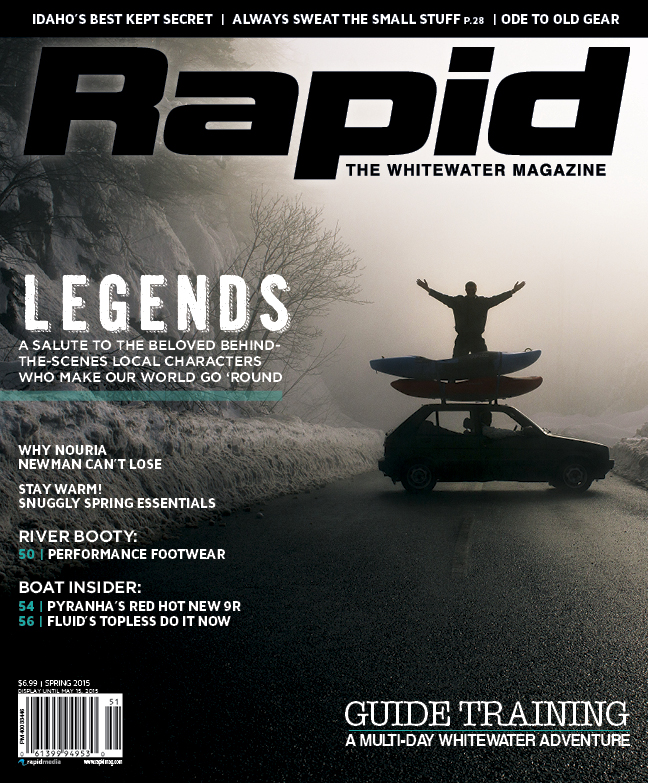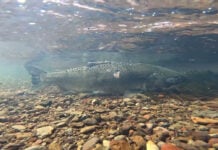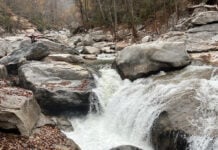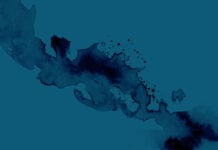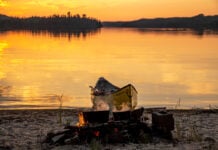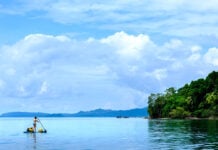THE PILOT
JIM REED
“If class V kayaking means you have to be focused and aware and mistakes mean injury or death, then every instant in the air in a helicopter is class VI. Jim Reed is quiet, humble and spectacularly skilled, with a deep understanding of these whirling masses of parts. He makes gravity disappear.”
Lofty impressions, especially coming from Doug Ammons, a whitewater icon and adventure sports pioneer. They attest to the level of intimacy between pilot and paddler—especially when venturing into the Grand Canyon of British Columbia’s Stikine River, a larger than life landscape that demands expertise and nerves of steel in the air as much as it’s a proving ground for the world’s best boaters.
Reed came to Canada from his native New Zealand in 1990 and eventually settled in the northern B.C. town of Dease Lake, flying for Pacific Western Helicopters. Like most chopper pilots, the majority of his flights transport geologists and supplies to drilling camps and fisheries biologists to mountain wildernesses. In between, he whisks tourists through the 72-kilometre-long, 300-metre-deep Stikine Canyon, which was first attempted by kayak in 1981.
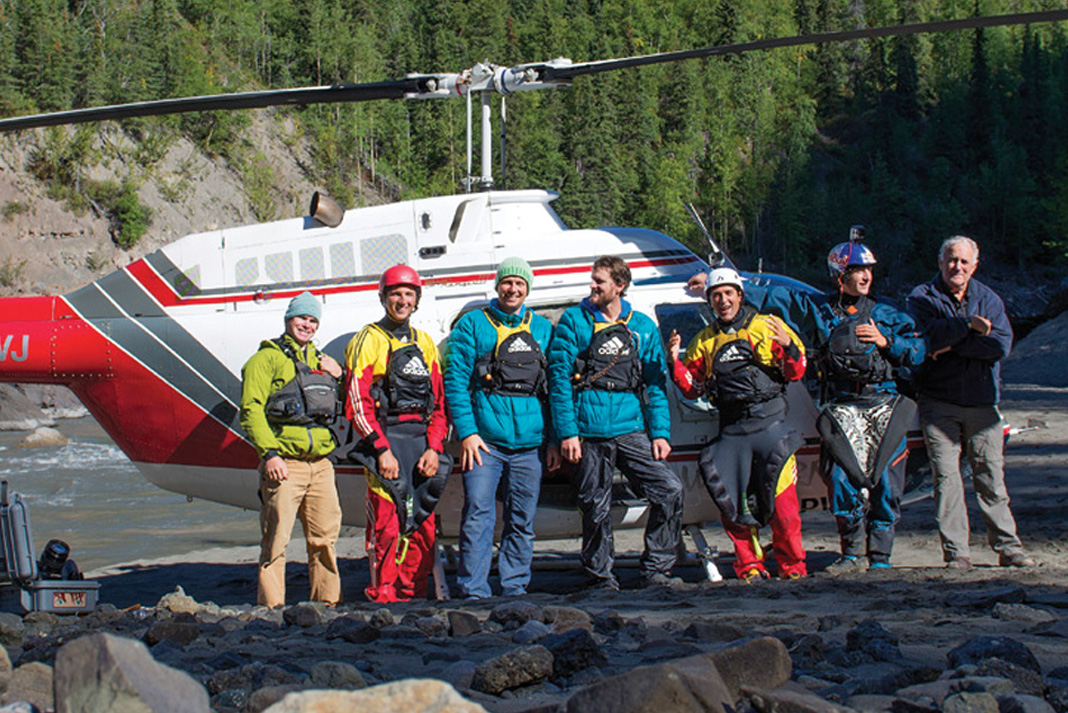
Reed became the go-to pilot for world-class paddlers looking for logistical and video support—and sometimes emergency extractions—from the air. His first group arrived in 1998, including Ammons, Rob Lesser, Gerry Moffat, Charlie Munsey, Wink Jones, Reggie Crist and a cameraman. “I’d often tried to picture a kayaker running the canyon and figured it would be too difficult,” says Reed. “Seeing these guys in their tiny boats I got a better feel for the actual size of the waves. I came to the conclusion that they were bloody nuts.”
That first expedition, which was completed successfully in three days, still ranks amongst Reed’s best memories. Besides sparking a long-time friendship with Ammons, Reed was struck by Lesser’s “tenacity of age”; the Stikine legend was 53 when Reed met him.
Ammons describes Reed as exuding a preternatural, “Yoda-like” calm behind the controls. Reed’s most hair-raising moments have come on account of the handful of unprepared paddlers he’s lifted out of the canyon—rescues involving precise landings, long lines and miniscule margins of safety. “Jim’s done this with for more than 30 years with quiet aplomb,” says Ammons. “He’s a master of the machine.”

THE ACTIVIST
MARTIN LITTON
CALIFORNIA-BASED JOURNALIST, editor and World War II vet Martin Litton first ran the Grand Canyon of the Colorado River in 1955. As a trivial claim to fame, he was the 185th person to descend the Grand since John Wesley Powell first did it in 1869; Litton’s distinction was rendered more anticlimactic by the fact that he was unable to paddle because of a shoulder injury. Yet the journey marked the beginning for a man whose legacy is as monumental as the canyon itself.
At the time, Litton was battling two proposed dams on the Green River that would flood the spectacular rock canyons of Dinosaur National Monument. Just as congress denied the dams on the Green—one of the first environmental victories in the United States—they approved the Glen Canyon dam on the Colorado River in 1956.
Meanwhile, the Bureau of Reclamation planned two more dams for the Grand Canyon itself. In 1963, directors of the San Francisco-based Sierra Club were prepared to capitulate when Litton addressed the board. Producing hand-drawn diagrams and quoting Theodore Roosevelt, Litton laid the Sierra Club’s intentions to waste. He argued that a dam would suppress the beating heart of the Grand Canyon—the free-flowing Colorado River.
“A MAN WHOSE LEGACY IS AS MONUMENTAL AS THE CANYONITSELF.”
“Martin doesn’t have to prime for a speech,” said the late David Brower, longtime Sierra Club board member and executive director. “Martin poured it on…and we voted ‘no.’” After a campaign that galvanized the environmental movement, President Lyndon Johnson rejected the dams in 1969.
Litton championed the intangible values of wilderness—its sublime beauty and spiritual power. He loved introducing Americans to the wild Grand Canyon, and launched an outfitting business in 1972. He was the only commercial outfitter to guide on the Colorado River exclusively in wooden dories—graceful, oar-powered boats as fragile in class V rapids as wilderness in the face of human onslaught.
Litton’s greatest attribute was his pig-headedness. Brower, widely revered as the greatest conservationist of all-time, called Litton his conscience. “When I would waver in various conservation battles, he would put a little starch in my backbone by reminding me that we should not be trying to dicker and maneuver,” said Brower. “I guess I got some of my extremism from Martin Litton, and I’m grateful for it.”
Litton ran the Grand Canyon for the last time at age 90. He died on November 30, 2014, at his home in Palo Alto, California. He was 97 years old.
“The American West has lost one of its great champions,” said current Sierra Club director Michael Brune, in a statement released December 1st. “His tenacious inability to surrender was an inspiration to the generations of environmental activists who followed in his wake.”
THE CRAFTSMAN
BRIAN SHIELDS
BRIAN SHIELDS WILL NEVER FORGET the moment he was smitten by the aesthetics of a whitewater canoe. “It was a Dagger Caption with wood trim and Tennessee cherry decks,” he says. “It was like looking at a sports car, the most beautiful thing I’d ever seen.”
In the late 1990s, Shields was an aspiring open boater, having recently retired from a career as a commercial airline pilot and residing north of Toronto, Ontario. The canoeing community is close-knit, and Mike Yee—the inventor of modern whitewater outfitting in the 1980s and the only one doing installations at the time—sensed his friend Shields’ interest in a retirement project. “He had the time to do installs,” says Yee. “I didn’t. More importantly, he’s a great woodworker. I knew he wouldn’t cut corners.”
“HE’S A GREAT WOODWORKER. I KNEW HE WOULDN’T CUT CORNERS.”
So Yee recruited Shields for a one-day crash course on whitewater outfitting. “It was like drinking water from a fire hose,” laughs Shields. By the end of the afternoon, the pair made a deal: Yee would supply airbags, saddles, straps and anchors, and Shields would install it—often along with graceful wood trim—to canoeists’ custom specs.
Shields became ingrained in the open boat community. He doesn’t have a website or promote himself on social media. For Sheilds, business is generated through glowing word-of-mouth reviews. Shields especially loves the thrill of putting his “beautiful machines” to work and paddling the gates with his wife, Gail. Last year, he and Rapid Media publisher Scott MacGregor won the senior men’s tandem title at Ontario’s Gull River Race—vindication after years of second-place finishes.
Shields has customized countless open boats in his 16 years of outfitting, but he remains as passionate about the canoe’s simple elegance as the day he started. “Installing wood is like cabinetwork,” he says. “Sometimes people ask for ash gunwales and grain-matched cherry decks. Those are the boats I hate to give back.”

THE RIVER GUIDE
CHRISTIE COCHRAN
FOR CHRISTIE COCHRAN, a love for flowing water is an inherited trait. Growing up in Texas, Cochran spent her childhood summers traveling and canoeing with her parents, both ardent river rats. They paddled the Guadelupe, San Marcos and Frio rivers in central Texas. When Mom and Dad learned about the Nantahala Outdoor Center (NOC), a Bryson, North Carolina-based whitewater facility with access to numerous southeastern rivers, they registered the family for canoeing and kayaking retreats.
As an earth sciences student at Trinity University in San Antonio, Cochran bucked family tradition (and her parents’ encouragement for her to be a river guide) to take on summer internships in geology. Upon graduating in 1998, she finally gave in and applied to NOC to work as a raft guide. As it happened, she also received a job offer to do geological research. “Mom said, ‘You’re going to be a raft guide,’” says Cochran. “So I moved east.”
Today, in between homeschooling her two children, Cochran still guides on some of the toughest rivers in the Southeast, including the Cheoah and Chattooga.
Now known as Mama Christie at NOC, Cochran estimates she’s guided more than 5,000 people down rivers in her 17-year career. She lists Mother Nature as her sole sponsor in a profile on NOC’s website.
“MOM SAID, ‘YOU’RE GOING TO BE A RAFT GUIDE,’ SO I MOVED EAST.”
Over the years, Cochran’s inspired other female guides and supported gender equality on the river.
“Guys can muscle their way down the river,” she notes “but women have to do it with finesse. Women are finding out that it’s something they can succeed at.”
Cochran is one of the few guides “checked off” to lead trips on all of the rivers NOC operates on, says Steven Foy, NOC’s director of guest relations and sales. “She’s one of the best river guides in the Southeast.”
“I first met Christie when I was one of her instructors for guide school in 1998,” says Cathy Kennedy, NOC’s director of operations. “We’ve been friends and coworkers ever since. I’ve been her boss and I’ve babysat her children. I know how hard it is to blend the life of a river guide with the challenges of raising a young family. Christie is one of the few women at NOC to have done this with success.”
At the moment, Cochran’s greatest responsibility is sharing her passion for the outdoors with her children. “I have a favorite picture of my infant son and I hiking up the trail from the Chattooga,” she says. “I have a boat on one shoulder and my son on the other. I’m a momma to a baby, and here we are on the river.”

THE SHUTTLE DRIVER
BRAD CAMDEN
A NEW STAY-AT-HOME DAD, Brad Camden had just moved to Gasquet, California, when a business opportunity appeared in his driveway. It was a kayaker looking for a ride to the put-in on the North Fork of the Smith River. Besides taking care of his six-month-old daughter, Camden was “walking circles in his living room.” That is to say, he was eager for a diversion. Driving the two-hour shuttle seemed like a good way to get out of the house, so “I said, ‘If you have room for a car seat, I’ll give you a ride,’” recalls Camden, 59.
That was 1986. Today, Camden, better known as Bearfoot Brad, remains the only shuttle driver for whitewater runs in northern California’s Smith River drainage. As his nickname suggests, Camden is known for his aversion to footwear. “Anybody can take their shoes off,” he laughs, “but it takes a long time to get bear feet.”
His house is on the main thoroughfare in Gasquet, and is described as a “miniature castle,” with three turrets and suits of armor in each window.
Camden is amazingly tolerant of paddlers’ quirks. “I would prefer if kayakers called the night before,” he says, “but I understand that in a lot of cases they might not know until that morning which fork they are going to float and how many drivers they’ll need.”
“I DON’T MAKE A LOT OF MONEY, BUT BILL GATES CAN’T AFFORD AN OFFICE AS PRETTY AS MINE.”
Because flows on the Smith depend entirely on precipitation, Camden keeps tabs on an improvised gauge on the river in Gasquet. He posts daily synopses on the website, Dreamflows.com. In the winter, when the forest service gives up maintaining the road to the North Fork, Camden routinely gets out and uses his four-wheel-drive truck to punch a path in the snow. “It wouldn’t be good business to get stuck,” he notes. “So I take it upon myself to keep the road open.”
Camden has only floated the Smith twice, but he loves to live vicariously through the stories of the paddlers he shuttles. He also battles to keep the watershed pristine. Camden once collected nearly 2,000 signatures on a petition opposing a nickel mine in the area. The proposed development was ultimately turned down.
Remarkably, Camden’s fees have only increased by $5 over the 29 years he’s been in business. “I hate to think you can’t float the river because you can’t afford it,” he says. “I don’t make a lot of money, but Bill Gates can’t afford an office as pretty as mine, and he doesn’t get to hang around as nice of people as I do.
“Whatever the paddlers do from Monday to Friday, I see nothing but smiles on faces when they’re going to float the North Fork of the Smith.”
 THE SALESMAN
THE SALESMAN
BRAD NELSON
WHEN BRAD NELSON SELLS SOMEONE THEIR FIRST KAYAK, he always jots a list of phone numbers, websites and Facebook pages on the receipt. As much as he enjoys selling kayaks, the Delta, Pennsylvania, retailer loves welcoming new people to the whitewater fraternity. After all, Nelson believes his Starrk-Moon Kayak Shop owes its existence to the network of boaters.
Nelson has been a paddler since his parents bought a farm near the Susquehanna River in the early 1970s. He was introduced to whitewater on Muddy Creek; eventually, he bought a house on the shuttle road to the creek, and opened a shop.
As for the region, “I call it a no-name whitewater area with a good amount of moving water,” says Nelson. “It isn’t North Carolina or the West, but West Virginia and the Water Gap is only a few hours away.” Dozens of local waterways flow high all winter, including Holtwood on the Susquehanna.
Starrk-Moon started as a canoe shop, but transitioned to kayaks when keyhole cockpits made close-decked boats less intimidating. Nelson’s big break came when he offered free boats and gear to a group of young skateboarders. “They went out and met the best local paddlers—guys I didn’t even know existed,” says Nelson. In turn, the skateboarders became expert paddlers, and shared their passion with a new generation. A dynasty took shape. “It’s been trickling down ever since,” says Nelson.
“LIVING AROUNDHERE AND NEVEROWNING A KAYAK ISLIKE LIVING ON THEBEACH AND NOT OWNING A BATHING SUIT.”
Nelson sells exclusively kayaks and paddling gear—“no tents, bows and arrows or sleeping bags”—in his unique, three-story shop, which is built into the side of a hill.
When he started taking trade-ins, Nelson realized that some of the old, classic boats he was getting from customers were too special to re-sell. So he started hanging vintage fiberglass Noah Boats from Czech-American builder Vladimir Vanha from the ceiling in his second floor “museum.”
“I hold onto them so people can appreciate them,” Nelson explains. The collection also includes composite prototypes for contemporary models, including the Pyranha Speeder, Jed and InaZone.
Nelson isn’t afraid to call himself a salesman. But with over 27 years of retail experience, he insists that selling kayaks comes with a moral obligation to create paddlers—something ignored in big box stores.
“I’ll tell people, living around here and never owning a kayak is like living on the beach and not owning a bathing suit,” says Nelson. “Kayaking is relatively cheap and it’s something you can do for the rest of your life. But you can’t be a loner. You have to get out and make those connections.”
This article first appeared in the Spring 2015 issue of Rapid magazine.
Subscribe to Paddling Magazine and get 25 years of digital magazine archives including our legacy titles: Rapid, Adventure Kayak and Canoeroots.




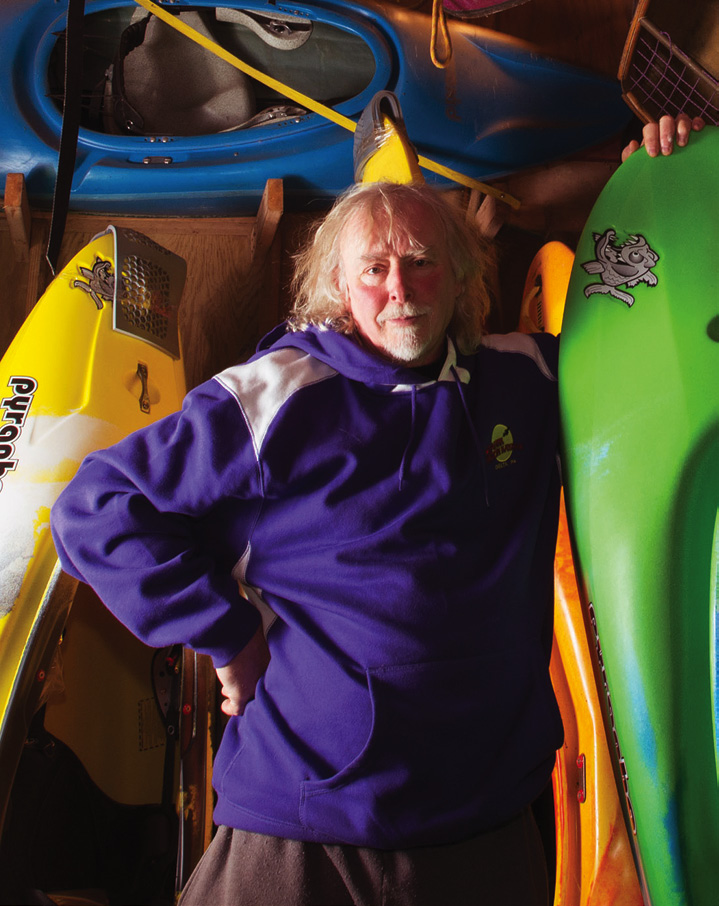 THE SALESMAN
THE SALESMAN